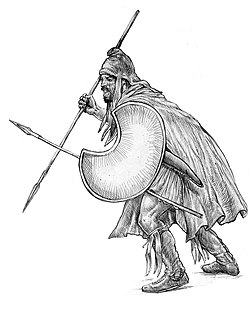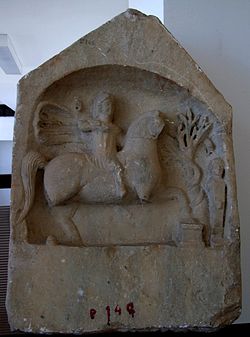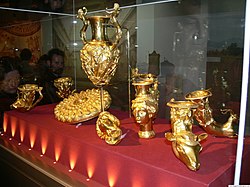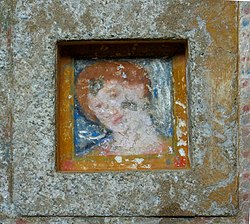| Revision as of 00:54, 7 January 2008 editMartijn faassen (talk | contribs)Extended confirmed users1,031 edits \← Previous edit | Revision as of 04:52, 7 January 2008 edit undoMonshuai (talk | contribs)987 edits Faassen, Dr. Poulianos says "Thracians like Bulgarians belong to the same anthropological type." Don't distort a direct quote from an anthropologist... Do you love vandalizing? Is this your hobby?Next edit → | ||
| Line 67: | Line 67: | ||
| ==Physical characteristics of the Thracians== | ==Physical characteristics of the Thracians== | ||
| Academic studies have concluded that Thracians had physical characteristics typical of Mediterreneans with dark eyes and hair. According to Dr. Beth Cohen, Thracians had “the same dark hair and the same facial features as the Greeks.”<ref>Cohen, Beth, ed., 2000, Not the Classical Ideal: Athens and the Construction of the Other in Greek Art, Leiden </ref> Furthermore, Dr. Aris N. Poulianos states that Thracians |
Academic studies have concluded that Thracians had physical characteristics typical of Mediterreneans with dark eyes and hair. According to Dr. Beth Cohen, Thracians had “the same dark hair and the same facial features as the Greeks.”<ref>Cohen, Beth, ed., 2000, Not the Classical Ideal: Athens and the Construction of the Other in Greek Art, Leiden </ref> Furthermore, Dr. Aris N. Poulianos states that Thracians like modern Bulgarians belong mainly to the Aegean athropological type.<ref>Poulianos, Aris N., 1961, The Origin of the Greeks, Ph.D. thesis, University of Moscow, supervised by F.G.Debets </ref> | ||
| In contrast, a well-known fragment, ] comments: | In contrast, a well-known fragment, ] comments: | ||
Revision as of 04:52, 7 January 2008
- "Thracians" may refer to any modern inhabitants of the geographic region of Thrace, regardless of ethnicity; see Thrace.


The ancient Thracians were a group of Indo-European tribes who spoke the Thracian language - a scarcely attested branch of the Indo-European language family. Those peoples inhabited the Eastern, Central and Southern part of the Balkan peninsula, as well as the adjacent parts of Eastern Europe.
Thracians inhabited the ancient provinces of: Thrace, Moesia, Dacia, Scythia Minor, Sarmatia, Bithynia, Mysia, Macedonia, Pannonia, and other regions on the Balkans and Anatolia. This area extends over most of the Balkans region, and the Getae north of the Danube as far as beyond the Bug.. The Thracian ethnicity and language are extinct. The branch of science that studies the ancient Thracians and Thrace is called Thracology.
Origins
The prehistoric origins of the Thracians remain obscure, in absence of written historical records. Evidence of proto-Thracians in the prehistoric period depends on remains of material culture. Proto-Thracian tombs can be found dating back to 3000 BC, when what can be termed as 'proto-Thracian' culture began to form. It is generally proposed that a proto-Thracian people developed from a mixture of indigenous peoples and Indo-Europeans from the time of Proto-Indo-European expansion in the Early Bronze Age when the latter, around 1500 BC, conquered the indigenous peoples.
Modern historiography linguistically classifies Thracians as an Indo-European people of the Eastern (satem) subgroup, which links them to Iranians, Slavs and Balts. Similarities with the ancient Iranian peoples (Scythians, Cimmerians, Sarmatians) are further confirmed by historical and archaeological evidence of early Thracian material culture, way of life, crafts, works of art and burial practices.
Others mentioned that "The region's name comes from the Thracian people who were of Indo-European stock. According to ancient sources, the Thracian peoples who settled and lived in the area of Haimos and Rhodope mountains were of warrior and primitive character whereas, another portion of the Thracian peoples that settled along the Aegean and Marmara coasts, in comparison to the former, were more peaceful and civilized."
Bulgarian scholars (Alexander Fol, Ivan Marazov, Elka Penkova) have theorised that Thracians were part of a wider "Thraco-Pelasgian" group of peoples, due to the observed parallels between the Thracian culture and the ancient Minoan, Mycenaean Greek and Phrygian cultures.
First historical record about the Thracians is found in the Iliad, where they appear as allies of the Trojans, hailing from Thrace.
Classical period
By the 5th century BC, the Thracian presence was pervasive enough to have made Herodotus (book 5) call them the second-most numerous people in the part of the world known by him (after the Indians), and potentially the most powerful, if not for their disunity. The Thracians in classical times were broken up into a large number of groups and tribes, though a number of powerful Thracian states were organized, such as the Odrysian kingdom of Thrace and the Dacian kingdom of Burebista. A type of soldier of this period called the Peltast probably originated in Thrace.

In that period contacts between the Thracians and Classical Greece intensified which led to strengthening Greek influences in Thracian society, culture and handcrafts. Because their language had no written tradition, in some regions the Thracian aristocracy and administration adopted Classical Greek for an official language and Thracian merchants utilised it as a 'lingua franca' in their contacts with other tribes and peoples. As a result a level of Hellenization was observed in the following centuries and it was deeper imposed by the Macedonian conquests over the Thracian territory in 3rd century BC.
Extinction of the ethnicity and language
See also Dacian language, Thracian language.

The ancient languages of these people had already gone extinct and their cultural influence was highly reduced due to the repeated barbaric invasions of the Balkans by Celts, Huns, Goths, and Sarmatians, accompanied by persistent hellenization, romanisation and later slavicisation. The ethnic contribution of the Thracian and Daco-Getic population, who had lived on the territory of modern Bulgaria and Romania has been long debated among the scientists during the 20th century. Some recent genetic studies suggest that these peoples have indeed made a significant contribution to the genes of these nations. After they were subjugated by the Macedonian king Alexander the Great and consecutively by the Roman empire, most of the Thracians eventually became Hellenised (in the province of Thrace) or Romanised (in Moesia, Dacia, etc.). The Romanised tribes of Dacia later became the ethnic substratum of the Vlach people (that first appeared in historical documents in the 10th century) who evolved into modern Romanians.
In the 6th century some Thracian tribes south of the Danube river made contacts with the invading Slavs and were later Slavicised. Thus they became one of the main ethnic elements in the consolidation of the Bulgarian nation in 8-9th century. Linguistic evidence about this is the presence of Thracian and direct Latin loanwords in Old Bulgarian and modern Bulgarian language.
Some scholars have proposed that present-day Albanians may be descendants of Thracian tribes who maintained their language. However this is highly controversial as the official Albanian historiography relates modern Albanians with the ancient Illyrian people. Bulgarian historians also consider it possible for the Vlach and Karakachani people of Bulgaria to be descendants respectively of Romanised and Hellenised Thracian tribes.
Archaeology
Further information: Thracian hoards
The archaeological research of the Thracian culture started in the 20th century and especially after World War II, mainly on the territory of Southern Bulgaria. As a result of intensive excavation works in the 1960s and 1970s a number of Thracian tombs and sanctuaries were discovered. More significant among them are: the Tomb of Sveshtari, the Tomb of Kazanlak, Tatul, Seuthopolis, Perperikon, the Tomb of Aleksandrovo, Sarmizegetusa in Romania, etc.
Also a large number of elaborately crafted gold and silver treasure sets from the 5th and 4th century BC were unearthed. In the following decades those were exposed in museums around the world, thus gaining popularity and becoming an emblem of the ancient Thracian culture. Since the year 2000, Bulgarian archaeologist Georgi Kitov has made discoveries in Central Bulgaria which were summarized as "The Valley of the Thracian Kings".
On 19 August 2005, some Bulgarian archaeologists announced they had found the first Thracian capital, which was situated near Karlovo in Bulgaria. A lot of polished ceramic artifacts (pieces of roof-tiles and Greek-like vases) were discovered revealing the fortune of the city. The Bulgarian Ministry of Culture declared its support to the excavations.
In Dabene, Bulgaria, a cache of more than 15,000 gold Thracian artifacts were discovered, including thousands of rings. In August 2006 a sensational archaeological find was made near the village of Dubovo. A Thracian dagger made of an alloy of gold and platinum, sharp, and in perfect condition, was found in a tomb near the village of Dubovo.
Sources
The Iliad records that the Thracians from around the Hellespont and also the Thracian Cicones fought on the side of the Trojans (Iliad, book II). The Odyssey records that Odysseus and his men raided Thrace on their way back home from war. Many mythical figures, such as the god Dionysus, princess Europa and the hero Orpheus were borrowed by the Greeks from their Thracian neighbours.
In book 7 of his Histories, Herodotus describes the equipment of the Thracians fighting under the Persians,
- The Thracians went to the war wearing the skins of foxes upon their heads, and about their bodies tunics, over which was thrown a long cloak of many colours. Their legs and feet were clad in buskins made from the skins of fawns; and they had for arms javelins, with light targes, and short dirks. This people, after crossing into Asia, took the name of Bithynians; before, they had been called Strymonians, while they dwelt upon the Strymon; whence, according to their own account, they had been driven out by the Mysians and Teucrians. The commander of these Asiatic Thracians was Bassaces the son of Artabanus.
In book 5, Herodotus describes the customs of various Thracian tribes.
- The Thracians who live above the Crestonaeans observe the following customs. Each man among them has several wives; and no sooner does a man die than a sharp contest ensues among the wives upon the question which of them all the husband loved most tenderly; the friends of each eagerly plead on her behalf, and she to whom the honour is adjudged, after receiving the praises both of men and women, is slain over the grave by the hand of her next of kin, and then buried with her husband. The others are sorely grieved, for nothing is considered such a disgrace.
- The Thracians who do not belong to these tribes have the customs which follow. They sell their children to traders. On their maidens they keep no watch, but leave them altogether free, while on the conduct of their wives they keep a most strict watch. Brides are purchased of their parents for large sums of money. Tattooing among them marks noble birth, and the want of it low birth. To be idle is accounted the most honourable thing, and to be a tiller of the ground the most dishonourable. To live by war and plunder is of all things the most glorious. These are the most remarkable of their customs.

A fresco of a red-haired noble woman in the Ostrusha Mound in central Bulgaria. - The gods which they worship are but three, Mars, Bacchus, and Dian. Their kings, however, unlike the rest of the citizens, worship Mercury more than any other god, always swearing by his name, and declaring that they are themselves sprung from him.
- Their wealthy ones are buried in the following fashion. The body is laid out for three days; and during this time they kill victims of all kinds, and feast upon them, after first bewailing the departed. Then they either burn the body or else bury it in the ground. Lastly, they raise a mound over the grave, and hold games of all sorts, wherein the single combat is awarded the highest prize. Such is the mode of burial among the Thracians.
In contrast, the Greek historian Strabo describes the Thracians living in twenty-two tribes.
Josephus claims the founder of the Thracians was the biblical character Tiras, son of Japheth:
- Thiras also called those whom he ruled over Thirasians; but the Greeks changed the name into Thracians. AotJ I:6.
Physical characteristics of the Thracians
Academic studies have concluded that Thracians had physical characteristics typical of Mediterreneans with dark eyes and hair. According to Dr. Beth Cohen, Thracians had “the same dark hair and the same facial features as the Greeks.” Furthermore, Dr. Aris N. Poulianos states that Thracians like modern Bulgarians belong mainly to the Aegean athropological type.
In contrast, a well-known fragment, Xenophanes comments:
- Men make gods in their own image; those of the Ethiopians are black and snub-nosed, those of the Thracians have blue eyes and red hair.

The contradiction between the physical characteristics of Thracians deduced from anthropological evidence on one hand, and Xenophanes' description on the other can be accounted for by analysing the uniform Hellas tribal classification perspective regarding 'barbarians' to the north. The Greeks identified themselves as civilized, while those to the north of their classical borders were seen as Barbarians. Greeks attributed differing physical features to the so-called barbarians then they did to themselves. A recent statistical comparison of ancient and modern Greek skulls resulted in the discovery of “a remarkable similarity in craniofacial morphology between modern and ancient Greeks.” Supportive of this study, American anthropologist J. Lawrence Angel noted that from the earliest times to the present “racial continuity in Greece is striking.” Buxton who had earlier studied Greek skeletal material and measured modern Greeks, especially in Cyprus, found that the modern Greeks “possess physical characteristics not differing essentially from those of the former .”
From this evidence, including the cited works by Cohen and Poulianos, it is clear that Ancient Greeks were themselves dark haired/eyed. Thus in order to disassociate themselves from those whom they saw as inferior, Greeks often attributed fair features to the less advanced ethnic groups while idealizing black hair and brown eyes, so-called dark features, by way of poetic words melanan and melampugos that functioned as symbols of strength, civilizaton and intelligence. The academic suggestion is that Greeks looked upon their northern neighbours, the Thracians, as culturally inferior barbarians who were according to the Xenophanes' reference described as having the typical barbarian feature of "purros" meaning red hair and blue eyes. This implies that while the two separate academic studies conducted by Cohen and Poulianos suggest that Thracians have also had dark features, Xenophanes described them as fair, because he was conditioned to view barbarians in general as having such physical traits.
Famous Thracians and Dacians

- Amadocus, a king after whom Amadok Point was named.
- Burebista was a king of Dacia between 70 BC - 44 BC who united under his rule Thracians in a large territory, from today's Moravia in the West, to the Bug river (Ukraine) in the East, and from Northern Carpathians to Southern Dionysopolis.
- Sitalces was a king of the Thracian Odrysian state. An ally of the Athenians during the Peloponnesian war
- Dionysus, the Thracian god of wine, represents not only the intoxicating power of wine, but also its social and beneficent influences.
- Orpheus, in Greek legend, was the chief representative of the art of song and playing the lyre, and of great importance in the religious culture of ancient Thrace and Greece.
- Spartacus was a Thracian enslaved by the Romans, who led a large slave uprising in what is now Italy in (73 BC - 71 BC). Before being defeated, his army of escaped gladiators and slaves defeated several Roman legions in what is known as the Third Servile War.
References
| Part of a series on |
| Indo-European topics |
|---|
 |
Languages
|
| Philology |
Origins
|
|
Archaeology
Pontic Steppe Caucasus East Asia Eastern Europe Northern Europe Pontic Steppe Northern/Eastern Steppe Europe
South Asia Steppe Europe Caucasus India |
|
Peoples and societies
Indo-Aryans Iranians East Asia Europe East Asia Europe Indo-Aryan Iranian |
Religion and mythology
Others
|
Indo-European studies
|
- The catalogue of Kimbell Art Museum's 1998 exhibition Ancient Gold: The Wealth of the Thracians indicates a historical extent of Thracian settlement including most of the Ukraine, all of Hungary and parts of Slovakia
- http://news.bbc.co.uk/2/hi/europe/5251266.stm Ancient dagger found in Bulgaria, BBC News (2006)
- http://books.google.com/books?id=LTbc1GIAwcIC&pg=PA105&lpg=PA105&dq=thracians+3000+bc&source=web&ots=_s1TWE7tWW&sig=b245pzLrZT2ukkSwMHGc88zgwRw The Celtic Encyclopedia, by Harry Mountain (1998), p. 105.
- Hoddinott (1981), p. 27.
- http://links.jstor.org/sici?sici=0026-1521%28197722%292%3A35%3A1%3C2%3ATT%3E2.0.CO%3B2-E&size=LARGE&origin=JSTOR-enlargePage The Thracians by Lionel Casson, p. 3.
- Strabo's Geography, Book VII, Fragments, paragraph 47
- Cohen, Beth, ed., 2000, Not the Classical Ideal: Athens and the Construction of the Other in Greek Art, Leiden
- Poulianos, Aris N., 1961, The Origin of the Greeks, Ph.D. thesis, University of Moscow, supervised by F.G.Debets
- Argyropoulos, E. et al., 1989, A comparative cephalometric investigation of the Greek craniofacial pattern through 4,000 years, Angle Orthod 1989 Fall;59(3):195-204
- Angel, J. Lawrence, 1944, A racial analysis of the ancient Greeks: An essay on the use of morphological types, American Journal of Physical Anthropology
- Buxton, L.H.D., 1920, Physical Anthropology of Ancient and Modern Greeks, Nature, v. 106, pp. 183-185
- Irwin, E., 1974, Colour Terms in Greek Poetry, Hakkert, Toronto
- Hoddinott, Ralph F. The Thracians. Thames & Hudson (1981), ISBN 0-500-02099-X.
- Best, Jan and De Vries, Nanny. Thracians and Mycenaeans. E.J. Brill Academic Publishers, Boston, MA. (1989), ISBN 90-04-08864-4.
See also
- Thrace
- Dacia
- Thracology
- List of Thracian tribes
- Odrysian kingdom
- Thracian language
- Thracian mythology
- Cimmerians
- Thraco-Cimmerian
- Thraco-Dacian
- Thraco-Illyrian
- Thraex
External links
- Bulgaria's Thracian heritage
- Ancient Bulgaria recent finds
- The Thracian tribes
- Thrace and the Thracians(700 BC to 46AD)